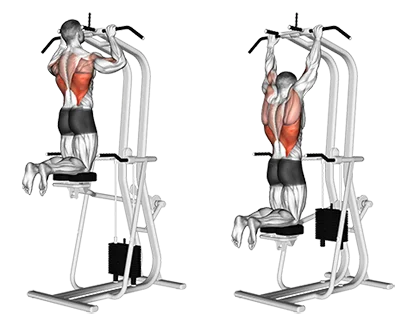Introduction
The Assisted Pull Up is an exercise that involves lifting one's body up from a hanging position using some assistance, typically provided by a resistance band or a machine. It targets the back, shoulder, and bicep muscles, enhancing their strength and endurance. This exercise is effective for those aiming to improve upper body strength, particularly pull-up capability, making it beneficial for fitness goals such as increasing functional strength, toning, and boosting performance in activities like rock climbing or gymnastics.
Muscles Worked
- Primary: Latissimus Dorsi, Biceps Brachii, and Back (Erector Spinae)
- Secondary: Deltoids, Teres Major, Forearm (Brachioradialis), and Abdominal Muscles
How to Do It (Step-by-Step)
- Stand under a pull-up bar with a shoulder-width grip. Your feet should be off the ground.
- Bend your elbows to lower your body until your upper chest touches the bar.
- Keep your core engaged, elbows close to your body, and avoid swinging or jerking movements. Exhale as you pull yourself back up to the starting position.
Tip: Beginners can use a resistance band for assistance. Always ensure the pull-up bar is secure before beginning.
Rep & Rest Guidelines
- Assisted Pull Up:
- Strength: 3–5 reps, 2–3 min rest
- Hypertrophy: 6–10 reps, 45–60 sec rest
- Endurance: 10–15 reps, 30–45 sec rest
Make your workouts more efficient with Auto Progression and never miss a rest again using the Rest Timer.
Form Tips
- Maintain a neutral spine and avoid excessive arching or rounding of the back.
- Keep the elbows close to the body during the movement for maximum effectiveness.
- Engage your core muscles to stabilize your body throughout the exercise.
When to Use It
- For novices learning to perform pull ups, assisted pull ups build upper body strength and confidence.
- Athletes recovering from shoulder injury can use assisted pull ups to regain pulling power without straining the injured area.
- Experienced exercisers can utilize assisted pull ups as a variation for targeting different muscle fibers during a workout routine.
- Workout History helps track your progress in various exercises, including assisted pull ups.
Assisted pull-ups are exercises that use equipment or help from a partner to make pull-ups easier, allowing for more reps and increased muscle activation.
Assisted pull-ups can help build strength, improve technique, and increase the number of pull-ups you can perform, leading to overall upper body development.
Equipment includes resistance bands, dip belts with weights, or a partner providing assistance during pull-ups.
Assisted pull-ups can benefit athletes of all levels. Advanced lifters may use them to increase volume and challenge their muscles.
A common recommendation is 3 sets of 8–12 reps, but this can vary based on your fitness level and goals.

